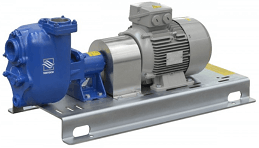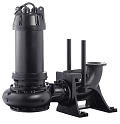Self-Priming Pumps vs Submersible and Immersion Pumps Guide
Submersible pumps are frequently used for emptying pits or transferring fluids from open tanks but is there a better solution?
With the requirement for ATEX equipment with diesel where ATEX submersible pumps were previously used is there an alternative?
Although the term Self-priming pump typically refers to an end suction centrifugal pump which has a self-priming pump head fitted, it actually covers a wide range of other pumping technologies from the positive displacement family including Air Operated Diaphragm, Peristaltic and progressive cavity which provides the ability to pump more viscous fluids such as oils, and sludges. Sometimes they can be used as true self-priming pumps above the tank, and in other applications immersed in the fluid.
Atex Fluids
In the past couple of years, diesel has been recategorized by DESEAR as a flammable liquid requiring ATEX equipment above certain pressures. 
With other reviews in ATEX certification and product adherence has led to manufacturers restricting submersible pumps for use with liquids which may contain kerosene, oils and diesel in submersible pumps.
This means that self-priming pumps or vertical immersion pumps are the only options.
Submersible pumps are often constructed from 304 or 316 plated metal which is welded together but the weld is often another material which is not as resistant to corrosion as the stainless steel making it a point of weakness for fluid entry.
Inspection & Maintenance
When there is an issue with a self-priming centrifugal pump detection of issues can be made easily through either sound, visible seal leakage or monitoring.
Should a motor failure occur providing the pump is long-coupled the motor can be sourced from alternative manufacturers quite different from the situation with submersible pumps. 
Submersible pumps require a physical inspection to detect issues or monitoring. As the motor is immersed within the liquid should seal failure occur the motor is susceptible to failure upon contact with water and require a rewind. Submersible pump motors are also inherently difficult to replace from other manufactures as the connection to the pump is within the housing meaning a pump replacement or rewind is typically the only viable option.
There are multiple ingress points into submersible pumps from the mechanical seal to the cable entry glands and motor seal housing.
| Liquid Handled | Self Priming | Submersible | Vertical Immersion |
| Flow | Low to high | Low to high | Low to high |
| Pressure | Low to high | Low to high | Low to high |
| Solid Handling | Low to medium | Low to high | Low to medium |
| Viscosity | Low to medium | Low | Low to medium |
| Maintenance | Back pull out design means maintenance performed easily without removal from pipework. | Confined space entry, 3 people as a minimum, pump can be much heavier on removal due to clogging, rags and wet wipes. Inspection regularly recommended. Motor in fluid means motor at risk of water entry.
| Requires crane for removal. Service intervals costly. Possible use of confined space entry. |
Submersible pumps remains an initial low-cost option for pumping applications however their overall installed cost and maintenance can be extremely high.  Confined space entry which is required for maintenance in commercial settings can cost as much as £2500 per entry thus eliminating any gains made by being cheaper on the first selection.
Confined space entry which is required for maintenance in commercial settings can cost as much as £2500 per entry thus eliminating any gains made by being cheaper on the first selection.
Self-Priming pumps require much less maintenance and oversight.




